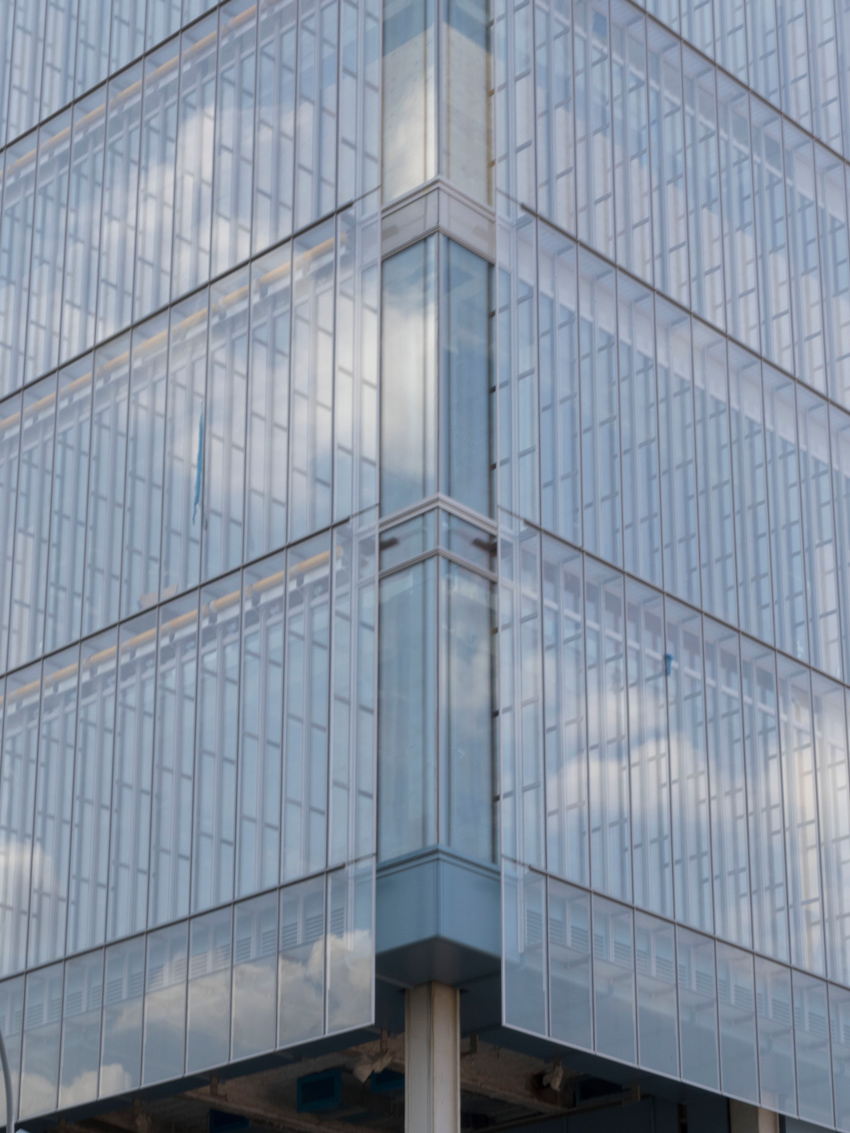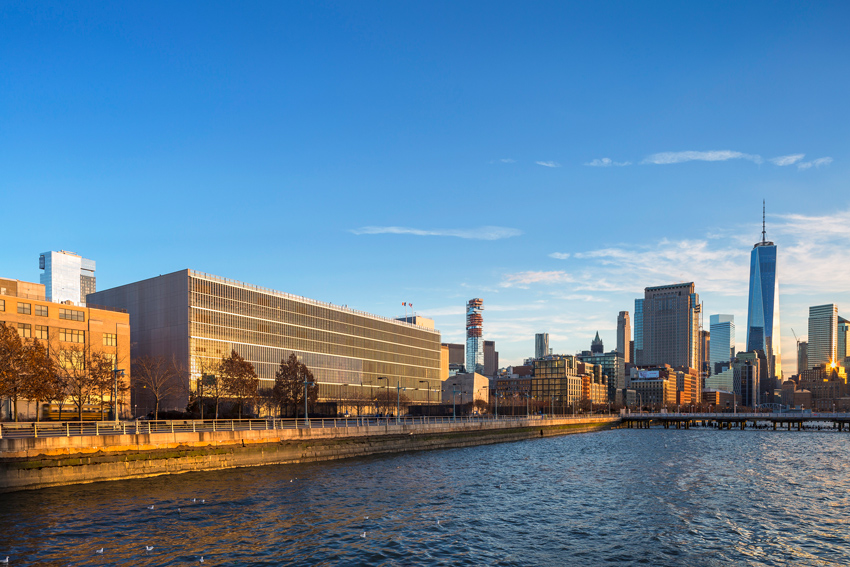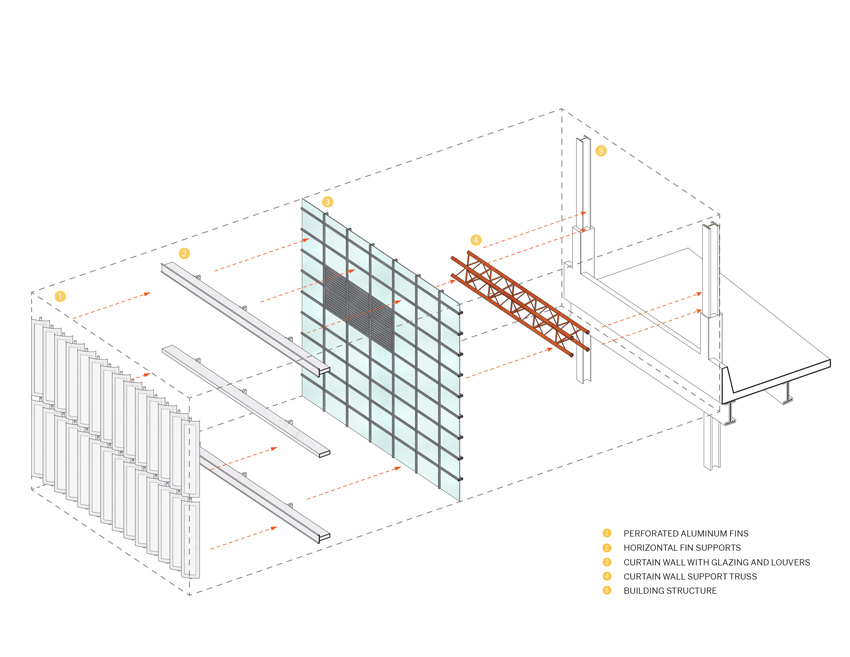Too Transparent?
JEROME L. GREENE SCIENCE CENTER
Another unique application of double-skin facade technology can be found at Columbia University’s Jerome L. Greene Science Center in Manhattan—designed by Renzo Piano Building Workshop and SOM—where a total of six different wall types were incorporated into the 10-story Center in which mind, brain, and behavior research initiatives are taking place.

Photo courtesy of Enclos
Six different wall types were incorporated into Columbia University’s Jerome L. Greene Science Center in New York City, designed by Renzo Piano Building Workshop and SOM, including a double-wall facade.
Stretched across the 175,988 square feet of building envelope, primarily fashioned with transparent floor-to-ceiling glass, are double-skin walls, high-performance structural facades, metal and glass canopies, and vestibules. While daylighting certainly played a significant role, it was actually the surrounding urban acoustics—including a train line within 60 feet of the building—that primarily drove the facade design.
“The facades of the Science Center more or less diagram the various internal building and external—including climate—forces acting on them,” states Patterson, whose firm customized and installed the facade systems. “For example, acoustic performance was the driver for the use of a double-skin strategy based upon the close proximity of the rail line and mitigating sound transfer to the interior.”
The double-skin facade itself is blast resistant, encompassing a total of 41,822 square feet. The exterior skin is made from laminated glass and consists of two ¼-inch lites with a PVB interlayer and mullions limited to 2½-inch sightline. The cavity is a small 16 inches in width, with a cast stainless steel bracket separating the two skins, and operable panels installed in every third module to allow for cleaning and maintenance of the interior shades.
In terms of the other facade systems, the first wall type is a custom stick-built storefront with insulated laminated glass supported by an AESS steel strong-back framing system incorporating 11 canopies. Wall two is a highly transparent blast-resistant system made from double insulated glass units, and the third wall type is the previously mentioned blast-resistant double-skin facade.
The fourth facade system features triple-insulated glass units, the fifth system is made of steel sheet panel cladding with exposed structural steel support, and the wall type number six is an opaque notch wall.
“This is a highly customized, complex and innovative facade system involving a demanding client and an uncompromising architect, which were all good things,” reflects Patterson. “The successful implementation of such a project requires the early involvement of the facade contractor in the design process, necessitating some form of collaborative delivery process as a strategy to mitigate the risk that accompanies complexity and innovation.”
“Enormous resources were committed to the development of the facade systems from concept design through the completion of visual and performance mockups,” he continues. “Before the activities of procurement, fabrication, assembly, and installation, the mockups are critically important to the success of the project.”
Because the facade was designed with minimal sightline obstructions, the fabrication tolerances were extremely tight. In order to achieve this, Enclos carefully sourced the building materials that were then assembled into prefabricated units at an off-site facility and delivered to the project site on a just-in-time basis.
MANHATTAN DISTRICTS 1/2/5 GARAGE
Just over in downtown Manhattan, the Manhattan Districts 1/2/5 Garage is yet another proof that double walls can be a viable high-performance option.
Designed by Dattner Architects and WXY Architecture Urban Design, the double-skin facade wraps the curtain wall with perforated, metal fins for the 425,000-square-foot facility housing three garages for the New York City Department of Sanitation.

Photo courtesy of Dattner
Designed by Dattner Architects and WXY Architecture Urban Design, Manhattan Districts 1/2/5 Garage features a double-skin facade and perforated, metal fins.
The double-facade evolved as a comprehensive design solution to multiple driving forces, according to Gia Mainiero AIA, a senior associate of Dattner Architects in New York. One was the desire to bring abundant natural light into the facility without compromising on heat gain, and a second was concerns that vehicular activity within the building be shielded from the surrounding community.
In addition, the double facade was a way to break down the mass of the full-block building into smaller, rhythmic elements, with the goal of playing on light and perspective to create an ever-changing facade experience.
Tracking LEED Gold, and a benchmark project for New York City’s Active Design program, the south facade’s operable aluminum 30-inch fins continuously track the sun’s location, and the building management system sets them perpendicular to the sun’s azimuth to ensure optimal shading. Meanwhile, the solar fins on the west and east elevation are fixed.
“The facade design developed through a series of computer models and solar analyses, followed by detailed investigations of appropriate materials and the creation of full scale mockups,” explains Mainiero. “The size of the solar fins was studied carefully to ensure that they stood up to the 400-foot length of the building and maintained visual interest.”
Furthermore, the perforation pattern was studied extensively, including the percent of open area, perforation size, and spacing, through samples and mockups.

Image courtesy of Dattner
To optimize daylighting and mitigate solar heat gain, the Garage’s perforation pattern—including the percent of open area, perforation size, and spacing—was studied extensively.
“The right balance was found to allow views out, reduce overall weight, and maintain a robust appearance consistent with the building’s design,” she explains. “Also, glass reflectivity was minimized to prevent extensive reflections of the sunshades and more patterns from occurring.”
As was the case with the previously noted double-skin facades, a high level of coordination and integration was required to support the project. In particular, the dynamic loading of the heavy equipment and vehicles within the building created a situation where the slab deflections exceeded those allowable by standard curtain wall systems. To address this, the architect, structural engineer, and facade consultant worked closely together to develop inventive structural anchoring details for both vertical and horizontal load supports.
The final design implemented a series of box trusses spanning the columns, used for the sole purpose of facade support and isolated from the vibrations and deflections of the structural slab, according to Mainiero.









